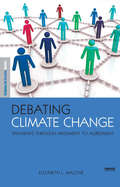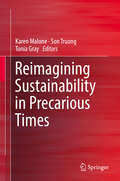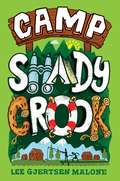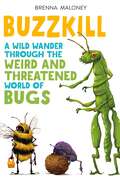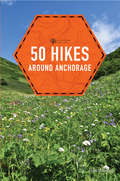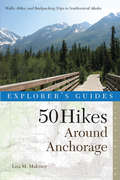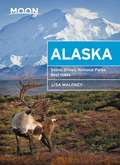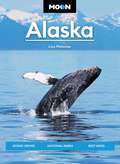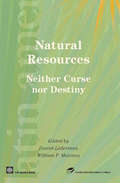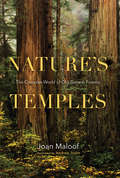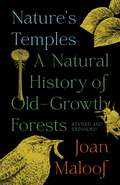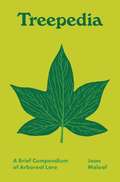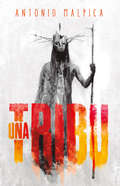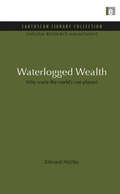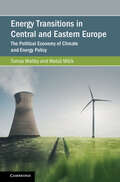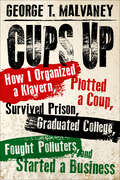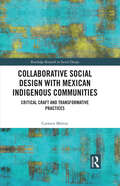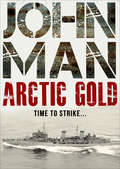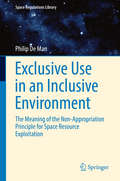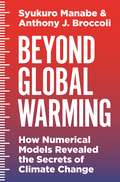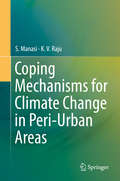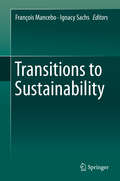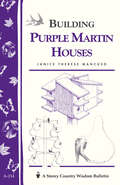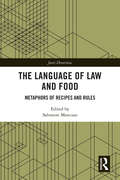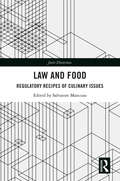- Table View
- List View
Debating Climate Change: Pathways through Argument to Agreement (The\earthscan Science In Society Ser.)
by Elizabeth L MaloneAs greenhouse gas emissions continue unabated and contentious voices fill the air, the question gains urgency: How can people with widely varying viewpoints agree to address climate change? Each participant in the debate seems to have a different agenda, from protecting economic growth in developing countries to protecting the energy industry in industrialized countries, from those aghast at the damage done to the Earth to optimists who think we just need to adjust our technological approach. Debating Climate Change sorts through the tangle of arguments surrounding climate change to find paths to unexpected sites of agreement. Using an innovative sociological approach - combined discourse and social network analyses - Elizabeth L. Malone analyzes 100 documents representing a range of players in this high-stakes debate. Through this she shows how even the most implacable adversaries can find common ground - and how this common ground can be used to build agreement. Written in a clear, accessible style, this original research and insightful use of communication analysis will help advance understanding and negotiation on climate change throughout the pivotal times to come. Published with Science in Society
Reimagining Sustainability in Precarious Times
by Karen Malone Son Truong Tonia GrayThis book reflects the considerable appeal of the Anthropocene and the way it stimulates new discussions and ideas for reimagining sustainability and its place in education in these precarious times. The authors explore these new imaginings for sustainability using varying theoretical perspectives in order to consider innovative ways of engaging with concepts that are now influencing the field of sustainability and education. Through their theoretical analysis, research and field work, the authors explore novel approaches to designing sustainability and sustainability education. These approaches, although diverse in focus, all highlight the complex interdependencies of the human and more-than-human world, and by unpacking binaries such as human/nature, nature/culture, subject/object and de-centring the human expose the complexities of an entangled human-nature relation that are shaping our understanding of sustainability. These messy relations challenge the well-versed mantras of anthropocentric exceptionalism in sustainability and sustainability education and offer new questions rather than answers for researchers, educators, and practitioners to explore. As working with new theoretical lenses is not always easy, this book also highlights the authors' methods for approaching these ideas and imaginings.
Camp Shady Crook
by Lee Gjertsen MaloneIt’s Ocean’s Eleven set in a summer camp as two kids try to one-up each other in a con competition at a camp that isn’t quite what it seems… <P><P>For Archie, the start of summer means another stint at Camp Shady Brook, where there is a lot more to the camp than meets the eye—just like Archie and his now blended family. But thanks to a con Archie developed last year, he’s finally somebody…and he’s not going to lose that status to the new girl, Vivian. <P><P> For Vivian, thanks to an incident That Shall Not Be Named or Spoken Of, her summer of exotic travels with Mom and Dad has turned into traveling to a dump of a summer camp in the middle of nowhere. But thanks to perfect timing, Vivian soon finds herself in a ring of kids trying to out-con each other—and discovers Camp Shady Brook is more like Camp Shady Crook. And when one final, massive con could cost Vivian the first friends she’s had in a while, can she and Archie figure out a way to make things right?
Buzzkill: A Wild Wander Through the Weird and Threatened World of Bugs
by Brenna MaloneyThe praying mantis is the only animal on Earth with one ear—and it’s in the middle of its chest. Aphids are born pregnant. Moths can’t fly during an earthquake. If you didn’t know these things, you soon will. Packed full of jaw-dropping facts, Buzzkill presents the big picture on bugs. You might think ew, gross. Insects are icky. Or scary. Or dangerous. They can be. But there’s so much more you need to know.Insects play a critical role on our planet, from sustenance to pollination to medicines and more. Brenna Maloney tackles both the wacky and weird, as well as threats to insects and their habitats, their possible extinction, and ways that everyday people, like you, can prevent their decline.Find out what all the buzz is about!Godwin BooksA JUNIOR LIBRARY GUILD GOLD STANDARD TITLE
50 Hikes around Anchorage (Explorer's 50 Hikes #0)
by Lisa MaloneyA hiker’s companion to the best treks within striking distance of Alaska’s largest city
Explorer's Guide 50 Hikes Around Anchorage (Explorer's 50 Hikes)
by Lisa MaloneyThe best hikes in--and beyond--the web of trails that covers the Anchorage area, from well-known treks to little-know gems. 50 Hikes Around Anchorage is your guide to exploring everything in this hub of cultural and outdoor life, from never-before-published wilderness routes to miles of mountain footpaths and National Recreation Trails. All hikes are within a 30-minute drive of the city and include such sites as the Iditarod Trail, Campbell Tract, Rendezvous Peak, Mount Baldy, and so much more. Routes pass over foothills and alongside streams, showcasing the region's natural beauty and pristine wilderness areas. You'll find cultural and natural history on each of the routes, detailed directions to the trailheads, GPS coordinates, topographic maps, information on local rules and regulations, and details on Leave No Trace ethics.
Moon Alaska: Scenic Drives, National Parks, Best Hikes (Travel Guide)
by Lisa MaloneyRemote, wild, and all-around otherworldly, Alaska promises unforgettable adventure. Discover the heart of "The Last Frontier" with Moon Alaska. Inside you'll find:Strategic itineraries, whether you have a week to hit the top sights or a month to explore the whole state, with ideas for outdoor adventurers, history buffs, road-trippers, wildlife enthusiasts, and moreThe top outdoor activities: Embark on a glacier hike, cast your line in the halibut capital of the world, or take an intrepid "flightseeing" tour to secluded glacier landings in Denali National Park. Experience the thrill of spotting wild bears, moose, wolves, or even a walrus, or hop on a boat at Columbia Glacier to watch sea otters, harbor seals, and whales glide through the water. Kayak on tranquil sounds and secluded lakes or camp under a crystal-clear sky full of starsUnique experiences: Learn about Alaska's native cultures, visit quirky small towns, and discover the best spots to witness the enchanting northern lightsHonest advice from Anchorage local and outdoor aficionado Lisa Maloney on when to go, what to pack, and where to stay, from campsites and hostels to B&Bs and resort fishing lodgesFull-color photos and detailed maps throughout, plus a full-color foldout mapHow to get there and get around by plane, train, ferry, cruise ship, or guided tourRecommendations for families, LGBTQ+ travelers, women traveling solo, seniors, international visitors, and travelers with disabilitiesThorough background on the culture, weather, wildlife, local laws, and history, plus tips for health and safetyWith Moon Alaska's practical tips and expert insight, you can find your adventure.Can't get enough of Alaska? Try Moon Anchorage, Denali & the Kenai Peninsula. Headed to Canada? Try Moon Vancouver & Canadian Rockies Road Trip or Moon Banff National Park.
Moon Alaska: Scenic Drives, National Parks, Best Hikes (Travel Guide)
by Lisa MaloneyRemote, wild, and all-around otherworldly, Alaska promises unforgettable adventure. Discover the heart of "The Last Frontier" with Moon Alaska. Inside you'll find:Strategic itineraries, whether you have a week to hit the top sights or a month to explore the whole state, with ideas for outdoor adventurers, history buffs, road-trippers, wildlife enthusiasts, and more The top outdoor activities: Embark on a glacier hike, cast your line in the halibut capital of the world, or take an intrepid "flightseeing" tour to secluded glacier landings in Denali National Park. Experience the thrill of spotting wild bears, moose, wolves, or even a walrus, or hop on a boat at Columbia Glacier to watch sea otters, harbor seals, and whales glide through the water. Kayak on tranquil lakes or camp under a crystal-clear sky full of stars Unique experiences: Learn about Alaska's native cultures, visit quirky small towns, and discover the best spots to witness the enchanting northern lights Honest advice from Anchorage local and outdoor aficionado Lisa Maloney on when to go, what to pack, and where to stay, from campsites and hostels to B&Bs and resort fishing lodges Full-color photos and detailed maps throughout, plus a full-color foldout mapHow to get there and get around by plane, train, ferry, cruise ship, or guided tour Thorough background on the culture, weather, wildlife, and history, plus health and safety tips With Moon Alaska's practical tips and expert insight, you can find your adventure. Headed to Canada? Try Moon Vancouver & Canadian Rockies Road Trip or Moon Banff National Park. About Moon Travel Guides: Moon was founded in 1973 to empower independent, active, and conscious travel. We prioritize local businesses, outdoor recreation, and traveling strategically and sustainably. Moon Travel Guides are written by local, expert authors with great stories to tell—and they can't wait to share their favorite places with you. For more inspiration, follow @moonguides on social media.
Natural Resources: Neither Curse nor Destiny
by William F. Maloney Daniel Lederman'Natural Resources: Neither Course nor Destiny' brings together a variety of analytical perspectives, ranging from econometric analyses of economic growth to historical studies of successful development experiences in countries with abundant natural resources. The evidence suggests that natural resources are neither a curse nor destiny. Natural resources can actually spur economic development when combined with the accumulation of knowledge for economic innovation. Furthermore, natural resource abundance need not be the only determinant of the structure of trade in developing countries. In fact, the accumulation of knowledge, infrastructure, and the quality of governance all seem to determine not only what countries produce and export, but also how firms and workers produce any good.
Nature's Temples: The Complex World of Old-Growth Forests
by Joan Maloof“Maloof eloquently urges us to cherish the wildness of what little old-growth woodlands we have left. . . . Not only are they home to the richest diversity of creatures, but they work hard for humans too.” —New York Times Book Review An old-growth forest is one that has formed naturally over a long period of time with little or no disturbance from humankind. They are increasingly rare and largely misunderstood. In Nature’s Temples, Joan Maloof, the director of the Old-Growth Forest Network, makes a heartfelt and passionate case for their importance. This evocative and accessible narrative defines old-growth and provides a brief history of forests. It offers a rare view into how the life-forms in an ancient, undisturbed forest—including not only its majestic trees but also its insects, plant life, fungi, and mammals—differ from the life-forms in a forest manipulated by humans. What emerges is a portrait of a beautiful, intricate, and fragile ecosystem that now exists only in scattered fragments. Black-and-white illustrations by Andrew Joslin help clarify scientific concepts and capture the beauty of ancient trees.
Nature's Temples: A Natural History of Old-Growth Forests Revised and Expanded
by Joan MaloofAn impassioned case for the importance of ancient forests and their preservationStanding in an old-growth forest, you can instinctively sense the ways it is different from forests shaped by humans. These ancient, undisturbed ecosystems are increasingly rare and largely misunderstood. Nature’s Temples explores the science and alchemy of old-growth forests and makes a compelling case for their protection.Many foresters are proponents of forest management, while ecologists and conservation biologists believe that the healthiest forests are those we leave alone. Joan Maloof brings together the scientific data we have about old-growth forests, drawing on diverse fields of study to explain the ecological differences among forests of various ages. She describes the life forms and relationships that make old-growth forests unique—from salamanders and micro-snails to plants that communicate through fungi—and reveals why human attempts to manage forests can never replicate nature’s sublime handiwork. This revised and expanded edition also sheds new light on the special role forests play in removing carbon from the atmosphere and shares what we know about the interplay between wildfires and ancient forests.With drawings by Andrew Joslin that illustrate scientific concepts and capture the remarkable beauty of ancient trees, Nature’s Temples invites you to discover the power of these fragile realms that are so inextricably connected to our planet, our fellow species, and our spirits.
Treepedia: A Brief Compendium of Arboreal Lore (Pedia Books)
by Joan MaloofA captivating A–Z treasury for the tree hugger in all of usTreepedia is an entertaining and fact-filled illustrated compendium of tree lore. Featuring nearly 100 entries—on topics ranging from tree ecology and conservation to the role of trees in religion, literature, art, and movies—this enticing collection is a celebration of all things arboreal.In this charming book, Joan Maloof explains the difference between a cedar and a cypress, and reveals where to find the most remarkable trees on the planet. She tells the story behind the venerable Bodhi Tree, and describes peculiar species like baobabs and Fitzroya. Maloof profiles legendary conservationists such as Julia "Butterfly" Hill, John Muir, Wangari Maathai, and Ken Wu. She discusses reforestation, proforestation, emerald ash borers, the ents from The Lord of the Rings, culturally modified trees, the ill-fated and controversial Redwood Summer, and much more. The book's portable size makes it the perfect travel companion no matter where your love of the forest may lead you.With enchanting illustrations by Maren Westfall, Treepedia is a fun and informative book that is guaranteed to inspire anyone who has ever enjoyed a walk in the woods.Features a real cloth cover with an elaborate foil-stamped designUses 100 percent recycled, uncoated, wood-free paper
Una tribu
by Antonio Malpica"Cada quién lleva un tatuaje distinto al de todos los demás en su interior. Y eso, a fin de cuentas, es su mayor fortaleza". "A veces siento que todo lo que impide al ser humano caminar descalzo por la hierba es una gran mentira." El gran jefe Tenaya y su pueblo habitan plácidamente el valle prohibido de Yosemite, a los pies del Capitán, el monolito preferido que hoy en día escalan los montañistas más atrevidos. Pero en 1850, aquella tribu tuvo que enfrentar una persecución sin tregua, una partida de ajedrez con los invasores del territorio piel roja. Petirrojo, hijo de Tenaya, sabe que su gente es de espíritu despreocupado, pero en su interior bullen las tribulaciones: la inseguridad frente a los talentos de sus hermanos, carismáticos y decididos; el temor de defraudar a su padre, y la vacilación ante el amor de Luz de Día, su amada desde niños. ¿Quién no ha temido quedar mal conquienes más le importan? A Tenaya le basta una vida simple y feliz para que su paso por la tierra sea provechoso, pero en ocasiones se necesita demostrar algo, a sí mismo y a los demás. Hasta ahora, Petirrojo no sabe para qué está en el mundo y se lo reprocha, pero se dará cuenta de que se necesita algo más que fuerza y astucia para vencer al enemigo, y poder así ser digno y libre. ¿Acaso una persona o una nación entera dejaría de existir si no alcanzara un sitio en la memoria del mundo? ¿Qué audacia tan grande se necesitará intentar en esta vida para que los demás te recuerden?
Waterlogged Wealth: Why waste the world's wet places? (Natural Resource Management Set)
by Edward MaltbyDon't drain the swamp! Man's traditional response to swamps, marshes and bogs has been to drain them. But wetlands are not wastelands. Coastal marshes are among the world's most productive ecosystems. They make many commercial fisheries possible and protect coasts from floods and storm surges. Wetlands are pollution filters, water reservoirs. They are among the last wild places on earth, offering homes to endangered plants, birds and animals. Attitudes to wetlands are changing, but not fast enough. As scientists are documenting the wealth in wet places, governments and developers are draining them, damming them, logging them and building resort hotels where ', they once were. Destruction is usually a poor trade-off: well-managed wetlands in Louisiana are producing fortunes in seafood and timber. Waterlogged wealth examines the value of swamps and marshes, as well as the threats against them. In doing so it takes the reader to some of the world's most bizarre landscapes: the 'inland delta' of the Niger River in drought-stricken Mali; the wildlife-rich Okavango swamps of Botswana; the waterlogged Sunderban forests of India and Bangladesh, where tigers eat fish and crabs. Civilisation began around wetlands; today's civilisation has good reason to leave them wet and wild. Dr Edward Maltby is a lecturer in geography at the University of Exeter(UK). He has done extensive research on wetlands both in the North (UK, US, Canada) and the South (Fiji, Jamaica, India and the Falklands/Malvinas Islands). He is on the IUCN Wetland Programme Advisory Committee. Originally published in 1986
Energy Transitions in Central and Eastern Europe: The Political Economy of Climate and Energy Policy (Cambridge Studies on Environment, Energy and Natural Resources Governance)
by null Tomas Maltby null Matúš MišíkThis book examines the mutual interplay of climate and energy policies in eleven Central and Eastern European countries in the context of the EU's energy transition. Energy security has long been prioritised in the region and has shaped not only national climate and energy policy, but also EU-level policy-making and implementation. Whilst the region shares economic, institutional and historical energy supplier commonalities it is not homogenous, and the book considers the significant differences between the preferences and policies of these member states. Chapters also explore the effect of the EU on member states that have joined since 2004 and their influence on the EU's energy and climate policies and their role in highlighting the importance of the concepts of security and solidarity. The book highlights the challenges to, and drivers of, energy transitions in the region and compares these with those in global energy transitions.
Cups Up: How I Organized a Klavern, Plotted a Coup, Survived Prison, Graduated College, Fought Polluters, and Started a Business (Willie Morris Books in Memoir and Biography)
by George T. MalvaneyGeorge T. Malvaney's life epitomizes the old maxim that "You cannot make this stuff up." Combine a young Klansman from Mississippi, an armed coup attempt in the Caribbean, a stay in prison, and a life-changing epiphany, and you have but half of this swashbuckling tale. Throw in the worst man-made ecological disaster in the history of the United States, and you have unleashed Malvaney's full life story. The Klansman, the soldier of fortune, the wild-eyed prisoner transforms into a renowned leader of the Mississippi Gulf Coast cleanup effort in the wake of the BP Deepwater Horizon oil spill.In his too-crazy-not-to-be-true memoir, Malvaney chronicles what easily should be several lifetimes of adventure--and misadventure. Growing up in a close-knit family in Jackson, Mississippi, the young Malvaney preferred woods and swamps to the drudgery of high school. He dropped out, enlisted in the Navy, and shortly afterwards joined the Ku Klux Klan. While onboard, he organized a branch of the Klan, corrupting and endangering his crewmen. After his discharge, he answered a mercenary call to take part in an invasion of Dominica, a Caribbean fiasco known as the "Bayou of Pigs." That madness landed him in a federal penitentiary. And there, somehow, he vowed to turn his life around.Cups Up, a title drawn from the wake-up call shouted at prisoners, is a story of perseverance, cleansing, and redemption. It chronicles the roller coaster life of a high school dropout, ex-Klansman, ex-mercenary, ex-felon, and ex-con, who went on to become a college graduate, a hardnosed environmental regulator, and a widely respected top executive in a company with more than a thousand employees.
Collaborative Social Design with Mexican Indigenous Communities: Critical Craft and Transformative Practices (Routledge Research in Social Design)
by Carmen MalvarThis book builds on the work of anthropologists, designers, and ethnographers to develop an original methodology and framework for indigenous engagement and designer/non-designer collaboration in the field of social design. Following a collaborative case study conducted over a five-year period between the author, project team, and indigenous artisans in Mexico, the book outlines the practical challenges of design research, including funding, logistics, relationships between designers and communities, failures, successes, and pivots. Social design literature has often focused on introducing important questions to the design research process, but fails to deeply interrogate and demonstrate how these theories inform research projects in action, which can then be open to misinterpretation, bias, and unintended harmful consequences. Centering the indigenous communities, this book provides a detailed and clear example of not just why, but how design and designers can work authentically and responsibly through different approaches and systems. The book examines the specific cultural, epistemological and socio-political history of Mexico as it relates to colonization and indigenous peoples, exploring the systemic influences of globalization and grounding the research in its unique context. It includes field notes, conversations with the indigenous artisan communities, workshops and prototypes to offer unique insight into a detailed, collaborative social design initiative. This book intersects with the growing awareness of the necessity of decolonial approaches to design across the world and will be an important and useful study for academics, students and researchers in social design, sustainable development, cultural studies and anthropology.
Arctic Gold
by John ManA man searches for the sunken treasure he once protected as a sailor in WWII in this “thrilling action story” from the acclaimed historian (Tom Kasey, author of Trade Off). Murmansk, Russia, 1942. The HMS Edinburgh is sailing deep in Russian territory, a bulwark against Nazi invaders. Among the eight-hundred-strong crew is Mike Cox, a sixteen-year-old boy from the East End, London who is about to be thrown into the heat of war. A Russian ship approaches the Edinburgh with a very precious cargo—over a thousand tons of gold—as payment from the Soviet Union for the Royal Navy’s protection. Now the English ship is tasked with safeguarding a fortune as well as the Barents Sea. But when a German U-boat fires torpedoes at the Edinburgh’s hull, the crew must fight for their lives . . . and Mike is one of only a few survivors to escape from the wreck as the gold sinks eight hundred feet to the bottom of the sea. After making his way back to London, Mike finds himself more alone than ever. He starts training to become a diver with one objective in mind: to rescue that precious Arctic gold. But he’ll have to act quick—he’s not the only one looking for it . . .
Exclusive Use in an Inclusive Environment
by Philip De ManThis book aims to find a workable interpretation of the non-appropriation principle that is compatible with both the existing international space law framework and the move of the private space industry towards the mining of asteroids and other celestial bodies. It does so by analysing the rules on the use of orbits as limited natural resources as a concrete indication of how space resources can be exploited by one user while respecting the non-appropriation principle and the interests of other users in space. This analysis is complemented by a thorough review of the meaning of property rights in the context of the existing international space law regime. This allows the author to distinguish between the lawful exploitation and unlawful appropriation of resources in a manner that could pave the way for a workable asteroid mining regime that takes into account the needs of individual companies and the international community. Exclusive use in an inclusive environment frames the legal regime of the exploitation of natural resources in outer space as the most pressing example to date of the tension that arises between the rights of a single spacefaring actor and the interests of the broader international community. Though academic in its approach in dealing with one of the most fundamental issues of space law to date, the book has very practical ambitions. By offering a pragmatic interpretation of the space law principles that are likely to remain the legal foundations of asteroid mining for the foreseeable future, Exclusive use in an inclusive environment hopes to inform academics, practitioners and policymakers alike in their future attempts at working out a fair, equitable and effective management regime for the exploitation of natural resources in outer space.
Beyond Global Warming: How Numerical Models Revealed the Secrets of Climate Change
by Syukuro Manabe Anthony J. BroccoliA definitive account of how we have come to understand the fundamental processes behind global warmingSyukuro Manabe is perhaps the leading pioneer of modern climate modeling. Beyond Global Warming is his compelling firsthand account of how the scientific community came to understand the human causes of climate change, and how numerical models using the world’s most powerful computers have been instrumental to these vital discoveries.Joined by atmospheric scientist Anthony Broccoli, Manabe shows how climate models have been used as virtual laboratories for examining the complex planetary interactions of atmosphere, ocean, and land. Manabe and Broccoli use these studies as the basis for a broader discussion of human-induced global warming—and what the future may hold for a warming planet. They tell the stories of early trailblazers such as Svante Arrhenius, the legendary Swedish scientist who created the first climate model of Earth more than a century ago, and they provide rare insights into Manabe’s own groundbreaking work over the past five decades. Expertly walking readers through key breakthroughs, they explain why increasing atmospheric carbon dioxide has caused temperatures to rise in the troposphere yet fall in the stratosphere, why the warming of the planet’s surface differs by hemisphere, why drought is becoming more frequent in arid regions despite the global increase in precipitation, and much more.Authoritative and illuminating, Beyond Global Warming is an invaluable insider’s look at some of today’s most cutting-edge Earth science, and a rare window into a brilliant scientific mind.
Coping Mechanisms for Climate Change in Peri-Urban Areas
by S. Manasi K. V. RajuThis book discusses the dynamics and resource management qualities of the peri-urban interface to address climate change consequences, focusing on the peri-urban region of the global city of Bengalaru. In 5 chapters, the authors document the unique challenges experienced in peri-urban areas, including soil-water vegetation dynamics, local and regional impacts on water bodies (surface and groundwater), food production issues, and the inhibited adaptive capacity of local communities. The book also provides knowledge on implementations of environmental management by local institutions, government interventions that have acted as catalysts in promoting community based adaptation strategies, and the physical, social and economic aspects of rural-urban dynamics. The book not only adds to the scarce existing literature on peri-urban contexts, but also addresses the role of culture in protecting ecological landscapes and how traditions play an important role in coping with climate change. Furthermore, the authors expand on these climate change coping mechanisms in peri-urban areas, taking into account local cultural factors and interesting governance interventions in the context of health. The book will be of interest to planners, policy makers, and students and researchers engaged in rural-urban dynamics and climate change adaptation.
Transitions to Sustainability
by François Mancebo Ignacy SachsThis book calls for the conditions of transition to sustainability: How to take into consideration new global phenomena such as and of the dimension of climate change, the depletion of natural resources, financial crises, demographic dynamics, global urbanization, migrations and mobility, while bearing in mind short-term or local place-based issues, such as social justice or quality of life? Meeting this challenge requires an inclusive approach of sustainability. It is a matter of designing a new social contract: Sustainability requires more than developing the right markets, institutions and metrics, it requires social momentum. To do so, many issues need a clear and complete answer: How to link social justice with sustainability policies? What governance tools to do so? What linkage between one decision-making level and the other? These are major issues to design sound transitions to sustainability.
Building Purple Martin Houses: Storey's Country Wisdom Bulletin A-214 (Storey Country Wisdom Bulletin Ser.)
by Janice Therese MancusoAttract and maintain a purple martin colony! Janice Mancuso shows you exactly how to do it. From finding the right site and choosing the best housing materials to constructing a martin house with suitable entrance holes and predator guards, you’ll find everything you need to know in this concise guide.
The Language of Law and Food: Metaphors of Recipes and Rules (Juris Diversitas)
by Salvatore MancusoThis book reconsiders the use of food metaphors and the relationship between law and food in an interdisciplinary perspective to examine how food related topics can be used to describe or identify rules, norms, or prescriptions of all kinds. The links between law and food are as old as the concept of law. Many authors have been using such links in creative ways to express specific features of law. This is because the language of food and cooking offers legal thinkers and teachers mouth-watering metaphors, comparing rules to recipes, and their combination to culinary processes. This collection focuses on this relationship between law and food and takes us far beyond their mere interaction, to explore different ways of using these two apparently so diverse elements to describe different phenomena of the legal reality. The authors use the link between food and law to describe different aspects of the legal landscape in different areas and jurisdictions. Bringing together metaphors and indirect correlations between law and food, the book explores different models of approaching legal issues and considering different legal challenges from a completely new perspective, in line with the multidisciplinary approach that leads comparative legal studies today and, to a certain extent, revisiting and enriching it. With contributions in English and French, the book will be of interest to academics and researchers working in the areas of law and food, law and language, and comparative legal studies.
Law and Food: Regulatory Recipes of Culinary Issues (Juris Diversitas)
by Salvatore MancusoThis book presents a range of insights on the relationship between food and law. Over time, religions have multiplied food prohibitions and prescriptions, customs have redistributed land, shared its occupancy in creative ways, or favoured communal property so that everyone could have access to food. In turn, laws have multiplied to facilitate food trade, security, safety, traceability, and also to promote and protect food and wine production, using trademarks and geographical denominations. This volume brings a comparative and interdisciplinary approach to examine some of the most heavily debated issues in the interaction between food, in all forms, and the law. Topics covered include food security, food safety, food quality, intellectual property, and consumer protection. As well as highlighting current issues, the work also points to new challenges in this field. The book will be a valuable resource for researchers and policy-makers working in the area of Food Law and Comparative Law.
